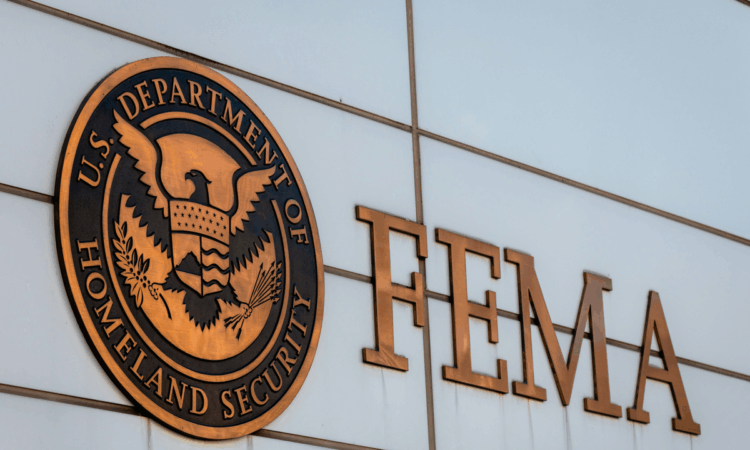Risk Spikes For Billions In Real Estate Investments As Federal Climate Funding Is Clawed Back

Canceled federal grants designed to protect cities across the U.S. from flooding, earthquakes and wildfires could endanger billions of dollars of commercial real estate assets.
President Donald Trump expanded a 30-year-old resiliency program run by the Federal Emergency Management Agency in his first term, resulting in $4.5B of grants distributed to roughly 2,000 projects over the past four years. But three months into his second term, the administration canceled the program, calling it “wasteful” and “politicized.”
Now, local governments across the country have been left trying to figure out how to plug multimillion-dollar funding gaps by themselves.

“That left dozens and dozens of communities thinking that they were going to receive federal funds to do their projects, and then suddenly in a lurch with the gap,” said Victoria Salinas, a former FEMA coordinator focused on disaster resilience and risk mitigation.
In 2018, the newly expanded and renamed Building Resilient Infrastructure and Communities program began offering grants to states and territories that had had major disasters in the past seven years to execute a hazard mitigation plan.
Under the program, projects in major cities can get up to 75% of a resiliency project funded by the grant, with that proportion going up to 90% for small communities.
Congress invested in the program via the bipartisan infrastructure law passed during the Biden administration. But FEMA announced in April that it would end the program, canceling all applications from fiscal years 2020 to 2023 and clawing back $882M in funding that hadn’t yet been spent.
By July, 20 states sued to reestablish the funding and were granted a preliminary injunction to stop the government from spending money previously set aside for BRIC grants. For projects already chosen for grants, the rescission means local governments have to drum up new funding by themselves to execute projects in stages rather than all at once, making them costlier.
But it isn’t just small communities caught in the crosshairs. It’s also commercial real estate owners all over the country.
Extreme weather events were twice as frequent in 2024 as during the previous two decades, according to NASA. Consequently, commercial property insurance costs keep rising, with J.P. Morgan estimating that premiums will rise by 80% by 2030.
Owners in markets where the government hasn’t already engaged in hazard mitigation are already facing higher insurance premiums because of the number of claims made, said Marcus Callegari, a commercial insurance producer for Hub International in South Florida.
“A lot of this responsibility falls on the city to make sure that they’re doing everything possible to lower the frequency and severity of these losses,” he said, adding that insurance markets are “red-hot” in areas without mitigation plans.
Risk will keep increasing without hazard mitigations, meaning owners will have fewer ways to get coverage, said Danielle Lombardo, vice chair of insurance and reinsurance provider Howden U.S.
“The underwriter would pull back on coverage. Some underwriters might pull out completely,” she said. “When the exposure increases, there’s volatility around the availability and whether or not the cost is prohibitive or not on the insurance side.”
New York, one of the states that sued, has 31 open BRIC projects worth an estimated $224.5M. Additionally, seven projects in the state that had already been awarded funding toward their total $138M costs are “in jeopardy of being defunded,” according to the suit.
New York was also set to receive a $50M BRIC grant for the Seaport Coastal Resilience Project led by the New York City Economic Development Corp. The funding rescission immediately endangers the Seaport project, whose total costs reach $228.8M and would have protected a historic Lower Manhattan neighborhood from flooding linked to sea level rise, more frequent rain and extreme heat events.
The impacts of federal funding cuts aren’t immediately clear, EDC spokesperson Seth Schuster said. But the cuts have left the city government searching for alternative funding methods to protect the already vulnerable area from flash flooding during thunderstorms.
“Climate change is still here,” Schuster told Bisnow by email. “The funding to fortify our vulnerable neighborhoods and protect our people should still be here too.”
A FEMA spokesperson told Bisnow by email that the BRIC program had “experienced extreme mission creep” during the Biden administration, saying that the program had become bureaucratic and slow-moving and that it had “prioritized frivolous projects like bicycle paths, shady bus stops, and planting trees.”
The agency has made more than $2B of resilience funding opportunities available to local, state, tribal and territorial governments since July, but it didn’t say if it had allotted funding to any projects.
The Seaport project’s BRIC grant would have directly protected 91 buildings, including public housing, that sit in the eight-block area. Any of the private properties in that area may have a harder time getting insurance as a result.
Increased insurance costs mean building is pricier, too. Developers are already incorporating those costs into projects as they go — especially in states like Florida, where landlords are having to swallow insurance costs that increased by 10% per apartment a year between 2017 and 2023.
“We’re just pricing additional costs in and as we’re evaluating new projects,” said David Becker, Time Equities head of equity strategy and senior managing director. “We’re basically of the assumption that insurance for climate events are substantially more.”
Unlike properties in areas that have already been leveled by climate events and are rebuilding from scratch, small owners and developers in towns where infrastructure is challenged but not destroyed by extreme weather events would see their properties’ destinies change if those neighborhoods could fund hazard mitigation efforts.

Bisnow/Ciara Long
Manhattan’s South Street Seaport neighborhood
“A large corporation has that ability to leverage a large policy, that they can put everything under one umbrella and spread cost,” Becker said. “When you can’t do that, you really are almost unable to do a project.”
Investments in resiliency projects offer massive savings for communities, Salinas said. That finding was echoed by a January 2024 study from the U.S. Chamber of Commerce, which found that every $1 spent on resiliency saves $13 in postdisaster economic damage and cleanup costs.
Since exiting FEMA, Salinas has been working with communities that need alternatives for BRIC dollars via a yearlong residency focusing on financing community climate adaptation through Duke University.
“There’s certainly been a fallout where communities understand their risk and want to do things and were left holding an empty bag by the federal government,” she said.
High Point, a 118,600-person city in North Carolina, is one of the communities that had applied for a BRIC grant and is now having to find a new way forward. The city wants to update the 100-year-old sewer system in its Southside neighborhood, which leaks tens of thousands of gallons of untreated wastewater into Richland Creek when it overflows during storms.
“We wanted to go in and take a good look at that system, make sure it’s in great shape so that as we continue to redevelop that area, that this is not an obstacle to that happening,” High Point Assistant City Manager Damon Dequenne said.
To even apply for the grant, the city had already completed the $2.7M of work for the project via in-kind services and, via a local nonprofit, had spent $30K on a consultant to put together its BRIC proposal.
While city officials had heard that the grant would be coming, they hadn’t received a letter from FEMA officially awarding the funding prior to the federal government rescinding BRIC grants.
But because it had been expecting to receive federal help, High Point now has additional administrative and financial tasks at hand while it tries to score more deals with private partners to complete the $7.3M of work that it would have used the BRIC grant for.
The sewer system’s issues also endanger private sector investments. The affected area has seen significant growth in the last four years: Public-private partnerships have invested more than $267M in High Point’s Downtown neighborhood, which is adjacent to the area where the city would have used the BRIC grant, said Rachel Collins, CEO and president of the city’s chamber of commerce, Business High Point.
High Point isn’t trying to scale back on the project’s size, but without the grant, it will likely have to pursue the project in phases rather than the most cost-efficient route of tackling everything at once, Collins said.
Collins is working with Salinas and a handful of Duke graduate students to build new financing models for the upgrades. One strategy could involve financing resiliency projects with revenues from government bond sales, as states like New York and California have done in recent years.
Another option is braiding the capital stack, Collins said. Projects can build a new capital stack made up of partnerships between the city, local philanthropic families and developers invested in the community. They can then interweave the loans and grants so portions of each loan go toward the same purpose, instead of each funding separate project stages.
But even with all of the parties collaborating with the city, it is a long way off from having a solution.
“Without that infrastructure improvement, we’re not going to be able to continue to develop and have that redevelopment be equitable across the community instead of just in little pockets,” Collins said. “It’s made us get back to the drawing board, but it’s made us think on a broader scale of collaboration.”




